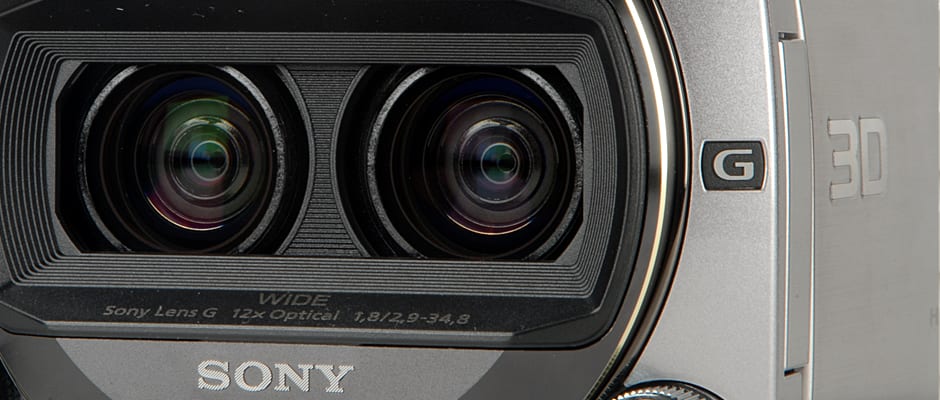Pros
Cons
Introduction
Front
{{section_header}}{{section.name}}{{/section_header}}

Back
{{section_header}}{{section.name}}{{/section_header}}

Left
{{section_header}}{{section.name}}{{/section_header}}
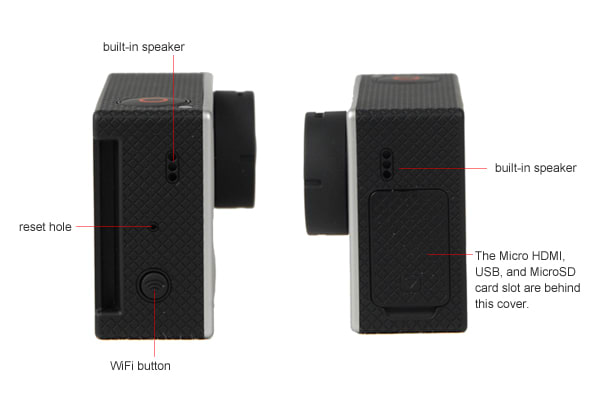
Right
{{section_header}}{{section.name}}{{/section_header}}
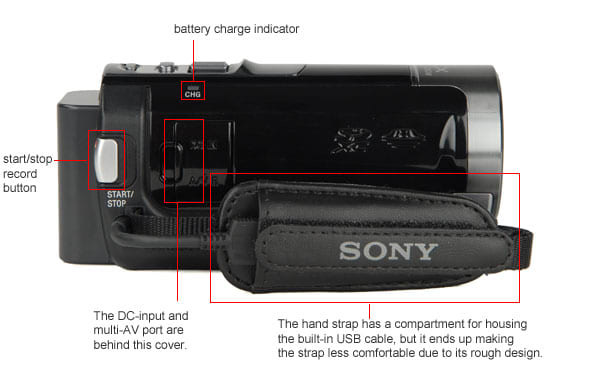
Top
{{section_header}}{{section.name}}{{/section_header}}

Bottom
{{section_header}}{{section.name}}{{/section_header}}

In the Box
{{section_header}}{{section.name}}{{/section_header}}

The HDR-TD10 comes with the following accessories:
- instruction manual
- software CD
- AV cable
- HDMI cable
- USB cable
- NP-FV70 rechargeable battery pack
- AC adapter
- remote control
Color
{{section_header}}{{section.name}}{{/section_header}}
The color accuracy results from our test with the Sony HDR-TD10 certainly didn't "wow" us, but the numbers weren't awful. The camcorder managed a color error of 4.8 with a solid saturation level of 100.1%. These numbers are eerily similar to what we got from the JVC GS-TD1 3D camcorder (4.8 color error and 92% saturation), and the color error is just a tad worse than what the Sony HDR-CX700V measured (it had a lower saturation level, though). More on how we test color.
Color Accuracy Performance
Color Error Map
The map above is a diagram of the color error. The length and direction of each line indicates how the camera processed each particular color while capturing video.
The Sony Handycam HDR-TD10 produced a color error of 4.80 and a saturation level of 100.60% in our bright light color testing.
To our dismay, the Sony TD10 has no color modes or color adjustment options. It does have a white balance shift feature that lets you bump the color temperature in a hot (red) or cool (blue) direction, but that's not the kind of thing we like to see here. For example, the flagship models from Canon (HF G10) and Panaosnic (HDC-SDT750 and HDC-TM900) have options for boosting saturation, smoothing skin tones, etc.
Sony Handycam HDR-TD10 Color Modes
Auto
100% Crop
{{comparison_bars title="Color Score Comparison", attribute="Color Score", xLabel="Color Score"}}
Low Light Color
{{section_header}}{{section.name}}{{/section_header}}
In low light, the HDR-TD10 did not do very well in our color accuracy tests. The camcorder registered a color error of 5.96 and a saturation level of 75.8%, both of which are significantly worse than the camcorder's bright light color scores. We would have liked to see better color accuracy here, but these numbers aren't much different than what we saw from Sony's HDR-CX700V camcorder that we tested earlier this year. The JVC 3D cam—the GS-TD1—did do a bit better than the Sony in this test, particularly with more color saturation (85%), but its results weren't dramatically ahead of the HDR-TD10. More on how we test low light color.
Low Light Color Accuracy Performance
Color Error Map
The map on the left is a diagram of the color error. The length and direction of each line indicates how the camera processed each particular color while capturing video.
The Sony Handycam HDR-TD10 produced a color error of and a saturation level of in our bright light color testing.
Using the 24p record mode with the TD10 resulted in deeper colors (a saturation level of 82%), but the color error did not improve significantly (down to 5.86 from 5.96). Some camcorders will show a strong improvement in low light color performance when using alternate frame rates, but this was not the case with the Sony TD10.
Noise
{{section_header}}{{section.name}}{{/section_header}}
Noise levels on the HDR-TD10 were equally unimpressive (just like the camcorder's color scores). The TD10's average noise level of 0.74% isn't bad, but it's not the kind of score we like to see from a top-of-the-line camcorder. Noise levels under 0.5%, like what the Panasonic HDC-SDT750 measured in this test, are the kind of numbers we like to see in this test. Of course, the Sony TD10's numbers aren't any different than what the JVC GS-TD1 measured in this same test. More on how we test noise.
{{comparison_bars title="Noise Score Comparison", attribute="Noise Score", xLabel="Noise Score"}}
Low Light Sensitivity
{{section_header}}{{section.name}}{{/section_header}}
Low light sensitivity is arguably the most important of our low light tests because it gives a good idea of how much light the camcorder will need to record a viable image. With the Sony HDR-TD10 we measured its 50 IRE score using a few different setups. First, we shot using a 60i frame rate and enough optical zoom so the camcorder could frame our test chart properly. In this manner, the TD10 required 26 lux of light to hit 50 IRE on our waveform monitor (50 IRE is the minimum illumination requirement for broadcast television). More on how we test low light sensitivity.
Zooming out, which allowed the TD10 to use a wider aperture and let more light hit the sensor, the camcorder needed only 9 lux of light to get an image with the same brightness. This is a much better score, but it's still not quite as good as the numbers we got from the JVC GS-TD1 or the Panasonic HDC-SDT750. On the bright side, the HDR-TD10 did do better in this test than the Sony HDR-CX700V.
Sometimes we see an improvement in low light sensitivity when we record using alternate frame rates. With the HDR-TD10, however, we saw no difference in sensitivity when using the camcorder's 24p record mode. Nor did we see any drop in low light sensitivity when shooting 3D content (something that can not be said about the Panasonic HDC-SDT750).
{{comparison_bars title="Low Light Sensitivity Comparison", attribute="Low Light Sensitivity Score", xLabel="Low Light Sensitivity Score"}}
Low Light Noise
{{section_header}}{{section.name}}{{/section_header}}
Noise was the best category for the Sony HDR-TD10 in our low light testing, but the camcorder still ranked behind the competition in this test. The TD10 averaged just under 1.5% noise in low light, which, while decent, is more noise than we measured on the JVC GS-TD1, the Panasonic HDC-SDT750, and the Sony HDR-CX700V. More on how we test low light noise.
Sony Handycam HDR-TD10 100% Crop
Strangely, we saw more noise in the TD10's low light video when we shot using the camcorder's 24p record mode. The increase wasn't drastic—just a bump of 0.1%—but we're more accustomed to seeing better noise performance with lower frame rates rather than worse.
{{comparison_bars title="Low Light Noise Score Comparison", attribute="Low Light Noise Score", xLabel="Low Light Noise Score"}}
Low Light Color
{{section_header}}{{section.name}}{{/section_header}}
In low light, the HDR-TD10 did not do very well in our color accuracy tests. The camcorder registered a color error of 5.96 and a saturation level of 75.8%, both of which are significantly worse than the camcorder's bright light color scores. We would have liked to see better color accuracy here, but these numbers aren't much different than what we saw from Sony's HDR-CX700V camcorder that we tested earlier this year. The JVC 3D cam—the GS-TD1—did do a bit better than the Sony in this test, particularly with more color saturation (85%), but its results weren't dramatically ahead of the HDR-TD10. More on how we test low light color.
Low Light Color Accuracy Performance
Color Error Map
The map on the left is a diagram of the color error. The length and direction of each line indicates how the camera processed each particular color while capturing video.
The Sony Handycam HDR-TD10 produced a color error of and a saturation level of in our bright light color testing.
Using the 24p record mode with the TD10 resulted in deeper colors (a saturation level of 82%), but the color error did not improve significantly (down to 5.86 from 5.96). Some camcorders will show a strong improvement in low light color performance when using alternate frame rates, but this was not the case with the Sony TD10.
Motion
{{section_header}}{{section.name}}{{/section_header}}
Motion video looked fantastic on the HDR-TD10, particularly when we shot using the camcorder's 60p record mode. In 60p mode, there was almost no presence of artifacting, smoothness was ideal, and trailing was only a minor issue. We did see some glitches during playback (a few jumps and stutters), but that's most likely to do with the power-intensive bitrate used by the camcorder's 60p mode. In 60i and 24p recording we saw a bit more artifacting, but the motion captured by the camcorder was still very smooth and had little in the way of trailing.
3D recording was less positive with the HDR-TD10. Yes, the camcorder captured some crisp imagery in 3D, but there was tons of blur, color bleeding, and flicker in all 3D videos we shot with the TD10. We'd say the 3D quality was comparable to that of the JVC GS-TD1. The Sony had a bit stronger 3D effect at times, but our eyes got tired very quickly when watching 3D clips—particularly ones that were shot outdoors with a bright background. The flicker on bright, moving objects was very straining to the eyes, and we found certain indoor shots (like our motion test) to be easier to view. More on how we test motion.
Video Sharpness
{{section_header}}{{section.name}}{{/section_header}}
The HDR-TD10 will capture sharp video shooting when shooting in any of its Full HD record settings. The camcorder did best with its 60p mode, although its overall sharpness numbers were a notch below that of the other camcorders we compared it to. The JVC GS-TD1, for example, was able to record 1000 lw/ph in our horizontal sharpness test and 650 lw/ph vertical. The Sony HDR-TD10 managed just 750 lw/ph for horizontal sharpness and 700 lw/ph for vertical when recording with its 60p mode. Again, these numbers are actually quite good, but they aren't among the best we've seen (as you can see from the score chart below).
In 60i record mode the HDR-TD10's sharpness numbers dropped a tiny bit. Horizontal sharpness went down to 700 lw/ph, while vertical sharpness took a dip to 600 lw/ph. Both are still decent scores, but we'd like these numbers to be a bit higher considering the TD10's upper-echelon price tag. Sharpness levels for the TD10's 3D recordings was even lower than the camcorder's 2D 60i numbers, although not by much. We estimated the horizontal sharpness at around 625 lw/ph and the vertical sharpness at 600 lw/ph. More on how we test video sharpness.
{{comparison_bars title="Video Sharpness Score Comparison", attribute="Video Sharpness Score", xLabel="Video Sharpness Score"}}
Ease of Use
{{section_header}}{{section.name}}{{/section_header}}
We wouldn't say the HDR-TD10 is the easiest 3D camcorder to use—that award would go to the ultracompact Sony Bloggie 3D—but wielding the TD10 isn't much of a challenge overall. Most controls aren't available in 3D mode anyway, so recording 3D video is similar to using the camcorder's dedicated auto mode, called iAuto, in 2D mode. You can adjust certain settings, like focus and white balance, when the camcorder is in 3D mode, but a short trip to the menu screen and you'll notice most options are grayed-out, which means they aren't available for adjustment. What we like most is that the camcorder will automatically adjust the 3D parallax when you use zoom with the camcorder or point the device at subjects who are various distances away from the lens. The camcorder does a good job automatically adjusting the 3D effect in most instances, so you don't have to do any calibration or 3D setup manually.
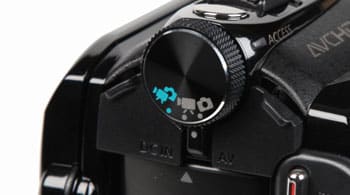
Auto Mode is confusingly called Dual Shot mode
We like iAuto mode on the HDR-TD10 for its simplicity and ease-of-use. The mode enables the camcorder to automatically select an appropriate scene mode based on the lighting conditions you are shooting under. It also puts the camcorder in an entirely automated shooting mode, and if you try to adjust any settings the camcorder will cancel iAuto mode. Outside of iAuto mode, the TD10's menu system allows you to pick and choose certain settings to adjust manually. This means you can only adjust focus manually and leave everything else on auto if you want, which is the way we like it.
Auto Mode
{{section_header}}{{section.name}}{{/section_header}}
The dedicated auto mode on the HDR-TD10 is called iAuto, and it's the same auto mode you'll find on all Sony's new Handycam camcorders. The iAuto mode works just like any other dedicated auto mode, that is it allows you to use the camcorder with entirely automated controls. The thing that is different about Sony's iAuto mode (compared to other manufacturers) is that you can still access the entire menu page when iAuto is engaged. If you select an option to adjust, however, a message will pop up saying "turn off iAuto mode." But you don't have to actually turn off iAuto to continue. You can simply select an option again, and iAuto will cancel automatically, thus allowing you to adjust any setting in the camcorder's menu.
This system is not good for very novice users who may accidentally find themselves in the TD10's complicated menu system without any idea what to do. But it is good for the mid-level user who may want to explore menu options while using iAuto mode to start. The iAuto mode can be used for 3D recording, but since most manual controls aren't available in 3D mode in the first place, the mode isn't all that helpful.
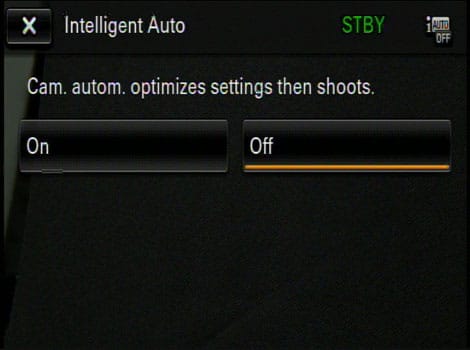
The iAuto mode button is difficult to find, but when you do find it the option for turning on the mode looks like this.
Auto Controls
{{section_header}}{{section.name}}{{/section_header}}
As is usual for Sony camcorders, the HDR-TD10 functioned very well with its automated controls. Autofocus was quick and accurate, as was auto exposure, in both 2D and 3D record mode. White balance was also good in auto mode for the most part, although we did find the camcorder to produce more accurate colors (particularly indoors) when we set the white balance manually.
Handling
{{section_header}}{{section.name}}{{/section_header}}
The Sony HDR-TD10 both feels and looks like a brick. We're not saying it's rough and colored red, mind you, but we're talking about the way it feels in the hand. It's got a heavy weight to it that we're not accustomed to feeling with a consumer camcorder. Older video cameras, like those that recorded to large VHS tape, were certainly bigger than the HDR-TD10, but compared to the average camcorder of today, the HDR-TD10 looks both large and heavy. The camcorder is also a nearly perfect rectangle with rigid sides and a thick, flat top. Its right side grip has some contoured design, but it doesn't provide an adequate grip.

These unique design elements are par for the course with 3D camcorders however, as the JVC GS-TD1 essentially has the same quirks with its size, wight, and design. We simply wish Sony had tried a bit harder to make the HDR-TD10 more ergonomic, particularly with the flat top of the camcorder. There's not much space for you to dig your fingertips in for a good grip of the device, and the awkward weighting of the camcorder makes it very difficult to hold steady. We're happy to see a large hand strap on the right side, however.

We were also impressed by the large LCD on the HDR-TD10, and, despite our earlier reservations, the glasses-free 3D effect on the screen can be quite good. It doesn't have a very wide viewing angle, and there is still a lot of ghosting if you point the camcorder at a moving subject, but the screen is far better than the one used on the JVC GS-TD1 (which also features a glasses-free 3D effect).


These dedicated buttons give you quick access to aperture and shutter speed controls.
Portability
{{section_header}}{{section.name}}{{/section_header}}
Compared to the modern-day consumer camcorder, the HDR-TD10 looks very bulky, but when you actually compare its dimensions to that of your average high-end camcorder, the TD10 really isn't that much larger. It's just sloppy design on Sony's part that makes the HDR-TD10 look thicker and clunkier than most consumer camcorders, as the TD10 has little in the way of sloped contours or ergonomic design. The actual dimensions of the TD10 are 74 x 86.5 x 148.5mm (2.25 x 2.6 x 5 inches), which, shockingly actually encompass less total volume than that of the Sony HDR-CX700V (92 x 76.5 x 174mm).
It is true that the HDR-TD10 is a lot heavier than its non-3D camcorder competition. It comes in at 740g (1.63 lbs) with its provided battery pack, which is around 250g heavier than Sony's top-of-the-line 2D model (the HDR-CX700V). The HDR-TD10 is slightly more compact than the JVC GS-TD1 3D camcorder, but it also weighs a bit more—so there's really not much of an advantage to either in terms of portability.
In the end, the HDR-TD10 is definitely not the camcorder to get if portability is a primary concern. It won't be able to fit into your pocket, and it isn't the type of camcorder that you can easily whip out of a purse or bag. It's big enough that you'll always know where it is and it is heavy enough to put strain on your hand during a long period of recording.
Battery Life
{{section_header}}{{section.name}}{{/section_header}}
Maybe it's because the camcorder ships with a larger battery than most consumer models, or maybe it's just stellar manufacturing on Sony's part, but the HDR-TD10 put forth the best battery performance we've seen in ages. The camcorder was able to continually record for 4 hours, 21 minutes, and 21 seconds in our battery life test (261 minutes), which is above and beyond our expectations for the camcorder. This is with the camcorder's provided battery pack, mind you, and this recording was done at the highest quality setting (2D recording) with the LCD open and powered the entire time.
The score chart below shows you how much better the TD10 did than the competition. It lasted nearly an hour and a half longer than the JVC GS-TD1, which had exceptional battery life in its own right (just not nearly as good as the TD10), and the battery lasted nearly double that of what the Sony HDR-CX700V showed us. More on how we test battery life.
For full disclosure, we must say that the HDR-TD10 comes with the NP-FV70 battery pack, which is larger than the NP-FV50 that comes with the CX700V. Since the battery compartment is the same on both camcorders, you could use either battery in either camcorder. Sony makes an even larger battery as well, the NP-FV100, which we can assume has an even longer battery life.

{{comparison_bars title="Battery Life Comparison", attribute="Battery Life Score", xLabel="minutes"}}
LCD
{{section_header}}{{section.name}}{{/section_header}}
The Sony TD10 has a 3.5-inch touchscreen LCD that features a glasses-free 3D view. This means you can see content in 3D without the aid of those silly 3D glasses. When we first looked into this technology last year at CES we weren't particularly impressed. But playing around with the LCD now, we've come to realize that it is the best glasses-free 3D LCD we've seen on a camcorder, and one of the best glasses-free 3D experiences we've had the pleasure of viewing overall.
The 3D effect is significantly stronger and less hard on the eyes than what you get on JVC's comparable LCD on the GS-TD1. It is also far better than the glasses-free 3D screen on Sony's own (admittedly cheaper) Bloggie 3D pocket camcorder (aka the MHS-FS3). This isn't to say the screen on the HDR-TD10 is perfect. It still produces blurred imagery and has a terrible angle of view. You need to look head-on at the screen to get a good 3D effect, and persistent use of the screen may give you a headache. Luckily, Sony added a feature that lets you switch the screen to 2D view, while still allowing you to record 3D video in the meantime.
The improved 3D performance of the LCD may have to do with the fact that the screen is simply well-built in the first place. It has a large, 3.5-inch viewing surface, and it makes use of a whopping 1.23-megapixels to produce stunning clarity and sharpness. Even without the glasses-free 3D view, this is one of the best LCDs we've ever seen on a consumer camcorder. The fact that the 3D view feature is pretty good just makes it all that much better.
Despite our love for the LCD on the TD10, we must mention that the camcorder has no viewfinder, which is something you do get on the Sony HDR-CX700V. There's certainly enough room for a viewfinder on the camcorder's bulky body, but maybe Sony didn't want to add to the already-large size of the HDR-TD10 by adding another component.
Stabilization
{{section_header}}{{section.name}}{{/section_header}}
Sony equips the HDR-TD10 with an optical image stabilization system (OIS) as well as an "active" setting that makes use of a combination of optical and digital stabilization features. Our testing showed the OIS worked fine, even in high shake situations, so we recommend sticking with the standard stabilization feature for most shooting situations. More on how we test stabilization.
In our low shake test, the TD10's standard stabilization reduced the shakiness of the video image by 44%. In our high shake test the camcorder's OIS did an even better job stabilizing the image, as it reduced 58% of the shake. Active mode produced far worse results in our testing, with the camcorder reducing shake by 17% in the low shake test and 19% in the high shake test.
What impressed us most was the fact that the HDR-TD10's stabilization system performed better than the OIS on the Sony HDR-CX700V. This isn't all that surprising (but it's still impressive), and we guess the TD10's stronger performance has something to do with its heavier body and rectangular, chunky design. Despite its bulk, however, the TD10 did not perform as well as the Panasonic HDC-SDT750 in this test (the Panasonic was one of the best camcorders we've seen in terms of stabilization ability). The TD10 did outperform the JVC GS-TD1, however, as you can see from the score chart below.
Manual Focus
{{section_header}}{{section.name}}{{/section_header}}
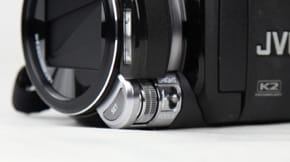
The adjustment dial makes accurate focus adjustments easy.
Miscellaneous Controls
{{section_header}}{{section.name}}{{/section_header}}
Tele Macro
Enables the camcorder to focus on close-up subjects using the full amount of optical zoom available on the TD10.
Guide Frame
An option for overlaying lines on the LCD that can be used to assist with framing and composing your shot. The lines don't end up in the recorded video—they're just guides for framing.
x.v. Color
Allows the camcorder to shoot using the xvYCC expanded color gamut. You'll only see a difference if you view the clips on an xvYCC-compatible television.
Auto Controls
{{section_header}}{{section.name}}{{/section_header}}
As is usual for Sony camcorders, the HDR-TD10 functioned very well with its automated controls. Autofocus was quick and accurate, as was auto exposure, in both 2D and 3D record mode. White balance was also good in auto mode for the most part, although we did find the camcorder to produce more accurate colors (particularly indoors) when we set the white balance manually.
Audio Controls
{{section_header}}{{section.name}}{{/section_header}}
The Sony HDR-TD10 has a built-in microphone that can record 5.1-channel surround sound audio, or simple 2-channel stereo. Additional audio features are plentiful—including a zoom mic option, wind noise reduction, and an audio level display—but there is no option for manual audio level adjustment. You can set the microphone to record at normal or low levels, however, but this is not nearly as much control as a full-fledged audio level adjustment feature would give you.
You can use external mics with the TD10, as the camcorder is outfitted with a 3.5mm mic jack as well as a hot accessory shoe that works with specific Sony accessory microphones.
Editing
{{section_header}}{{section.name}}{{/section_header}}
The HDR-TD10 ships with the PC-only software Picture Motion browser (PMB) version 5.5. It's the same software that has come with Sony camcorders for years, and 5.5 is the latest version of the software (and also came with the Sony HDR-CX700V). The main benefit of the software is that it allows you to import video clips from the camcorder, including the new 60p, 24p, and 3D clips that can be recorded with the TD10. Many traditional editing programs, like iMovie, Final Cut, and Adobe Premiere, have been shown to have trouble with the 60p clips shot with the Sony HDR-TD10, so the inclusion of the PMB software is very important if you're planning on working with 60p footage on a computer. For an overview of the software that ships with this and other camcorders, see our article: Video Editing Software For Your Camcorder{{product.brand.name}}-Included-Software.htm.
Compression
{{section_header}}{{section.name}}{{/section_header}}
Due to its ability to record 3D video, as well as the presence of a 1080/60p option, the Sony HDR-TD10 contains a number of different compression formats. Basic 2D recording on the camcorder uses AVCHD compression, which is the normal compression system for consumer HD camcorders and is nothing special. When shooting 3D video, the camcorder makes use of an original format Sony calls MVC. This enables the HDR-TD10 to record two Full HD images simultaneously (Double Full HD), which is something not possible with AVCHD.
The 60p frame rate option on the camcorder also makes use of an original recording format because AVCHD cannot be used to record 1080/60p footage. The downside of this original format is that we found it to be extremely incompatible with most editing systems. In fact, just the presence of 60p footage shot with the TD10 on a memory card would cause certain editing programs (iMovie and Final Cut Express) to crash the instant we attempted to import any video footage (even non-60p clips!).
The HDR-TD10 also employs a basic MPEG-2 compression system for the camcorder's standard definition record mode. Most HD camcorders do not offer standard definition recording in addition to high definition, but Sony is one of the few exceptions, as it offers standard def modes on nearly its entire HD line. Read more about the advantages and disadvantages of various high definition compression types.
Media
{{section_header}}{{section.name}}{{/section_header}}
Sony stuffed the HDR-TD10 with 64GB of internal flash memory—that's memory with no moving parts. 64GB is certainly a lot of internal memory to have on a camcorder, but it only gets you a little over 5 hours of record time at the highest quality setting.
So, what do you do if you want more space for recordings? That's what the memory card slot is for. The TD10 is equipped with a dual-format card slot that works with SD-type cards (SD, SDHC, or SDXC) as well as Memory Stick PRO Duo cards. We love that Sony allows for the use of SD cards on its camcorders these days, but the design of the dual-format slot is a bit finicky. The slot needs to be larger to accommodate SD cards, so inserting a thinner Memory Stick card into the slot can be tricky. Read more about the advantages and disadvantages of various media types.

Still Features
{{section_header}}{{section.name}}{{/section_header}}
The Sony HDR-TD10 has lots of still image features, but, most importantly, it does not have the ability to capture 3D photos. This disappoints us, not because we're super excited about taking 3D photos, but because we simply wonder why Sony didn't implement this feature? It seems like a no-brainer to include an option like this, and Sony does offer it on the ultracompact Bloggie 3D camcorder, so why not here? Perhaps a technical limitation made this feature not possible?
The regular photo options on the TD10 are plentiful, like we said, but none of them are all that exciting. There's a self-timer, smile shutter, various photo size options, and even a dedicated photo mode that prioritizes still image settings over video. You can also take still photos in video mode, and the option of snapping a photo during recording is present as well.
Lens & Imaging System
{{section_header}}{{section.name}}{{/section_header}}

As you can see from the photo, the HDR-TD10 has a dual lens system, which is in place to enable the camcorder to record 3D videos. What you can't see from the photo, however, is that the camcorder also has two 1/4-inch CMOS sensors. This allows the TD10 to record what Sony calls "Double Full HD" 3D video. Two Full HD video clips are recorded simultaneously and are overlapped in order to create the 3D effect. This is identical to the highest-quality 3D setting available on the JVC GS-TD1, although that camcorder has other 3D recording options as well.
In the table below, we've listed the camcorder's lens specs during 2D recording. The 3D recording specs are a bit different: a 56-degree recording angle and a focal distance of 2.9 - 29mm. Basically, this means the optical zoom in 3D mode is 10x, while the zoom capability is 12x in normal 2D record mode.
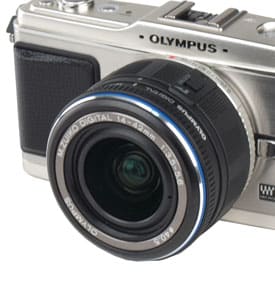
LCD
{{section_header}}{{section.name}}{{/section_header}}
The Sony TD10 has a 3.5-inch touchscreen LCD that features a glasses-free 3D view. This means you can see content in 3D without the aid of those silly 3D glasses. When we first looked into this technology last year at CES we weren't particularly impressed. But playing around with the LCD now, we've come to realize that it is the best glasses-free 3D LCD we've seen on a camcorder, and one of the best glasses-free 3D experiences we've had the pleasure of viewing overall.
The 3D effect is significantly stronger and less hard on the eyes than what you get on JVC's comparable LCD on the GS-TD1. It is also far better than the glasses-free 3D screen on Sony's own (admittedly cheaper) Bloggie 3D pocket camcorder (aka the MHS-FS3). This isn't to say the screen on the HDR-TD10 is perfect. It still produces blurred imagery and has a terrible angle of view. You need to look head-on at the screen to get a good 3D effect, and persistent use of the screen may give you a headache. Luckily, Sony added a feature that lets you switch the screen to 2D view, while still allowing you to record 3D video in the meantime.
The improved 3D performance of the LCD may have to do with the fact that the screen is simply well-built in the first place. It has a large, 3.5-inch viewing surface, and it makes use of a whopping 1.23-megapixels to produce stunning clarity and sharpness. Even without the glasses-free 3D view, this is one of the best LCDs we've ever seen on a consumer camcorder. The fact that the 3D view feature is pretty good just makes it all that much better.
Despite our love for the LCD on the TD10, we must mention that the camcorder has no viewfinder, which is something you do get on the Sony HDR-CX700V. There's certainly enough room for a viewfinder on the camcorder's bulky body, but maybe Sony didn't want to add to the already-large size of the HDR-TD10 by adding another component.
Connectivity
{{section_header}}{{section.name}}{{/section_header}}
Sony clumps a majority of the HDR-TD10's ports on the back side of the camcorder, but you'll also find a few ports on the right side as well as an accessory shoe on the top of the model. On the back, you'll find two well-constructed port covers that flip open to reveal four terminals running vertically down the back of the TD10. There's a mic jack at the top, a headphone jack beneath it, and the mini HDMI below that. Sony's proprietary multi-AV port, which works with the provided AV cable as well as a number of other cables available from Sony's online store, is at the bottom of this port cluster. Sony does not ship a Component cable with the HDR-TD10, but the camcorder does come with an HDMI cable instead.
Swinging around to the right side of the camcorder you'll see a semi-hidden sliding door that conceals the USB terminal and DC-input. Both the AC adapter for the DC-input and a USB cable come with the camcorder, so you don't have to worry about purchasing additional cables to work with these ports.
On the top of the camcorder is another proprietary connectivity feature: Sony's hot accessory shoe. We call this shoe "proprietary" because it only works with Sony accessories, although there are third-party manufacturers that make adapters that may work with the accessory shoe as well. The cover to the accessory shoe is somewhat difficult to open, and once you do open it, the shoe itself can be hard to access due to its indented design.
The last connectivity feature on the HDR-TD10 is the memory card slot. The slot, which is located inside the LCD cavity and behind a small cover, works with all types of SD memory cards (that's SD, SDHC, or SDXC), as well as Sony's own Memory Stick PRO Duo cards. Up until a few years ago, nearly all of Sony's products worked with Memory Sticks only, so the inclusion of SD card compatibility is a big step for improving the versatility of Sony products. While we do love the idea behind this dual-format card slot, we must admit the design of the slot isn't the greatest. It fits SD cards with ease, but the thinner Memory Stick cards can be frustrating to insert.
Battery
{{section_header}}{{section.name}}{{/section_header}}
For full disclosure, we must say that the HDR-TD10 comes with the NP-FV70 battery pack, which is larger than the NP-FV50 that comes with the CX700V. Since the battery compartment is the same on both camcorders, you could use either battery in either camcorder. Sony makes an even larger battery as well, the NP-FV100, which we can assume has an even longer battery life.

Media
{{section_header}}{{section.name}}{{/section_header}}
Sony stuffed the HDR-TD10 with 64GB of internal flash memory—that's memory with no moving parts. 64GB is certainly a lot of internal memory to have on a camcorder, but it only gets you a little over 5 hours of record time at the highest quality setting.
So, what do you do if you want more space for recordings? That's what the memory card slot is for. The TD10 is equipped with a dual-format card slot that works with SD-type cards (SD, SDHC, or SDXC) as well as Memory Stick PRO Duo cards. We love that Sony allows for the use of SD cards on its camcorders these days, but the design of the dual-format slot is a bit finicky. The slot needs to be larger to accommodate SD cards, so inserting a thinner Memory Stick card into the slot can be tricky. Read more about the advantages and disadvantages of various media types.

3D Lens
{{section_header}}{{section.name}}{{/section_header}}
Like the JVC GS-TD1, the Sony HDR-TD10 has a twin lens and sensor system in order to create 3D content. This is very different from the 3D lens conversion system used by Panasonic on its HDC-STD750 and as an option on other Panasonic models (like the TM90 and TM900). The benefits of having a built-in 3D lens system are better quality 3D images and less need for lens calibration. Of course, two lenses also means a heavier, larger camcorder, and those lenses are always there weighing the camcorder down—even when you're recording 2D content.
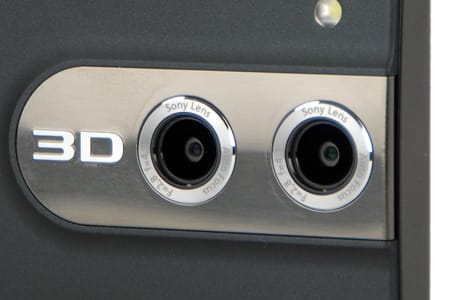
The second built-in lens is what lets you record video in 3D—without any tricky calibration.
As we stated above, the TD10 doesn't need any extensive calibration in order to capture 3D video with the camcorder. There is a 3D depth adjustment option, however, which essentially allows you to set the intensity of the 3D effect. The camcorder attempts to do this all automatically, and it does so quite well most of the time, but you can fiddle with the 3D depth adjustment manually if you want to fine-tune the look of your 3D videos. This is far simpler than the complex calibration system required on Panasonic's 3D-capable camcorders, and it is nearly identical to the 3D adjustment settings offered on the JVC GS-TD1.
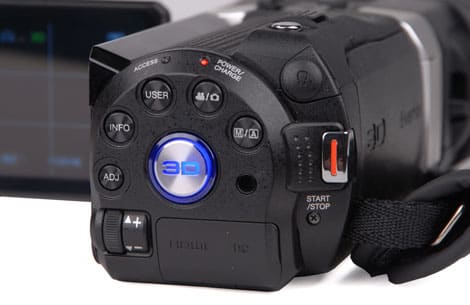
You can adjust a variety of controls—including zoom and focus—in 3D record mode.
3D Controls
{{section_header}}{{section.name}}{{/section_header}}
With its fancy control dial and strong selection of manual controls in 2D mode, we had hoped the HDR-TD10 would be chock-full of manual features in 3D recording as well. We were wrong. The only manual controls available in 3D mode are focus and exposure. You can't even set white balance manually in 3D mode, which is a shame. You can use optical zoom when shooting 3D, however, and with its 10x zoom the HDR-TD10 offers the most zoom of any 3D camcorder on the market.
As for 3D control adjustment, we did mention the 3D depth control above, which can be set using the touchscreen LCD or with the control dial on the front of the camcorder. You can even adjust the 3D effect during playback, although we found the interface to be terribly designed. It is nearly impossible to adjust the 3D depth during playback unless you have the camcorder connected to a 3D HDTV, as the small LCD simply doesn't give you enough 3D depth to make any accurate changes to the 3D effect.
3D Playback
{{section_header}}{{section.name}}{{/section_header}}
To watch 3D content recorded by the HDR-TD10 we hooked the camcorder up to two different Samsung 3D HDTVs. Both televisions recognized the HDR-TD10 immediately, and, when switching the camcorder to 3D mode, the TVs automatically switched to 3D mode as well. Selecting 3D clips for playback was no different than selecting a regular clip for playback. You simply tap the thumbnail of a clip and it begins playing on the camcorder's LCD or on an HDTV in which it is connected to. The only difference is that you must put the TD10 into 3D mode in order to select 3D videos for playback.
The glasses-free 3D LCD was better than we expected it to be, although it wasn't nearly as good as actually watching the 3D clips on an HDTV. The reason it was "better than we expected" was mostly due to the fact that we were supremely disappointed with the glasses-free 3D screens on other camcorders: the JVC GS-TD1 and Sony Bloggie 3D. The screen on the HDR-TD10 actually looks good in 3D mode, although it still has a terrible viewing angle and lots of ghosting. But at least you can really see things in 3D, and the images look much sharper than the glasses-free screens on the other two models we mentioned. Don't expect to be blown a way by the screen, but we stand by the statement that this is the best glasses-free 3D LCD we've seen on a camcorder so far.
Still Features
{{section_header}}{{section.name}}{{/section_header}}
The Sony HDR-TD10 has lots of still image features, but, most importantly, it does not have the ability to capture 3D photos. This disappoints us, not because we're super excited about taking 3D photos, but because we simply wonder why Sony didn't implement this feature? It seems like a no-brainer to include an option like this, and Sony does offer it on the ultracompact Bloggie 3D camcorder, so why not here? Perhaps a technical limitation made this feature not possible?
The regular photo options on the TD10 are plentiful, like we said, but none of them are all that exciting. There's a self-timer, smile shutter, various photo size options, and even a dedicated photo mode that prioritizes still image settings over video. You can also take still photos in video mode, and the option of snapping a photo during recording is present as well.
Other Features
{{section_header}}{{section.name}}{{/section_header}}
Golf Shot
This feature is entirely designed to capture and analyze a golf swing. When you turn it on, the screen is cropped on the left and right and a small white box appears in the middle of the frame. You are meant to position the golfer within this box and a message tells you to press the start/stop record button “right after impact” (we assume this is referring to the golf club hitting the golf ball). The feature works best if the camcorder is on a tripod or laying flat.
After you do all this, the camcorder will take the short bit of footage and divide into a bunch of still images. This way you can see frame-by-frame analysis of your golf swing. Maybe this feature could be used for other analysis, but the limitations on image size and record time make this difficult. Can’t Sony tweak this feature for a baseball swing analysis? Maybe next year.
Smooth Slow Record
A simple slow motion mode, Smooth Slow Record, will capture 3 seconds of footage and turn it into 12 seconds of slow motion video (by recording with a 240fps frame rate). The video quality isn’t great, so we recommend using this function sparingly, but it can create some cool effects. The main problem is the 3-second recording limitation. You can also set Smooth Slow Record to capture the three seconds of footage before or after you hit the record button.
Fader
You can add fades to the beginning or end of your video clips by turning this feature on in the menu system.
Panasonic HDC-SDT750 Comparison
The JVC GS-TD1 and the Sony HDR-TD10 are the only two full-fledged 3D camcorders on the market aimed at consumers. Yes, the Panasonic HDC-SDT750 records 3D video, but it does so by using a removable 3D lens converter, so that camcorder must be put into a separate category for now. Picking a winner between the TD1 and TD10 is a difficult task, and not only because they have such frustratingly similar names.
Let's start with the JVC TD1's advantages. It has more manual controls in 3D mode as well as more options for 3D recording. So, if you like choices and freedom, the JVC GS-TD1 is the 3D camcorder you should go with. The Sony HDR-TD10, on the other hand, has a single 3D record mode and offers little in the way of control when shooting 3D. The Sony's benefits include a much better 3D LCD and more optical zoom in 3D (10x vs. 5x on the JVC). Both camcorders are easy to use in 3D mode, and neither require the complication lens calibration techniques that are necessary with the 3D-capable camcorders from Panasonic.
The fact that JVC and Sony seemed to agree on a $1500 price tag for these two 3D camcorders makes this decision even more difficult. We found the Sony to be the better 2D camcorder overall, thanks to the inclusion of 24p and 60p frame rate options (something the JVC does not have). But when comparing these models solely based on their 3D capabilities, the JVC takes the cake.
Honestly, though, neither of these camcorders blew us away with their 3D performance. So, our best recommendation is to have you wait it out until next year when, hopefully, a number of new 3D camcorders will be available for consumers. Or you could avoid the 3D trend entirely and stick with recording plain old 2D video in brilliant HD instead.
Sony Handycam HDR-CX700V Comparison
The more we think about it, the more we like Panasonic's concept for 3D recording. The HDC-SDT750 is a 3D capable camcorder, rather than a full-fledged 3D model. To record in 3D with the SDT750, you must use the provided 3D lens converter (model name VW-CLT1). This converter is also available for purchase (at an additional cost, of course) for the Panasonic HDC-TM900 and Panasonic HDC-TM90 camcorders, among others. This strategy means the Panasonic HDC-SDT750 is a 2D camcorder first and a 3D camcorder second, which is not how we would describe the Sony HDR-TD10 or JVC GS-TD1.
We like this setup because, frankly, we haven't been overly impressed by the 3D performance of any camcorder that has come through our labs. And, since we think most users will end up recording more 2D footage than 3D, the idea of a camcorder that has the option of recording 3D but is primarily a 2D camcorder is very intriguing. The Panasonic HDC-SDT750 is an excellent camcorder that we may recommend to people even if they have no need for 3D recording—it's just that good of a 2D camcorder. Again, this is not something we'd be able to say about the JVC TD1 or the Sony TD10.
We are assuming here, however, that 3D is a novelty to most people, and that the quality of the 3D effect isn't all that important at the moment. So, let's be clear: if you want the best 3D performance from your camcorder, you should not go with the Panasonic HDC-SDT750 or any Panasonic models. It doesn't capture 3D video with the clarity, sharpness, or depth of the Sony HDR-TD10 or the JVC GS-TD1. It also has far less controls in 3D mode (you can't even zoom in 3D!) than the Sony or JVC models.
COMP 3
Some may describe the Sony HDR-CX700V as the HDR-TD10 without the ability to record 3D video. Those who describe it this way would be wrong, however. The CX700V is a better camcorder for recording 2D video, thanks in part to its larger, single CMOS sensor. Because of its larger sensor, we found the CX700 recorded sharper video than the HDR-TD10, although not by as much as we had thought it would. Other features found on the CX700V that are absent from the TD10 include: GPS, an electronic viewfinder, a built-in USB cable, better still image resolution options, a wider-angle lens, and more manual controls (like zebra patterns and focus assist features).
Besides being able to record 3D video, the HDR-TD10 also has the advantage of a larger and crisper LCD (with glasses-free 3D technology), better image stabilization, and longer battery life with its provided battery pack. Obviously, the 3D recording ability is the most important factor when deciding between these camcorders, and if you have no desire to record 3D then you shouldn't even be thinking about purchasing the HDR-TD10.
The HDR-CX700V is not the best high-end 2D camcorder we have reviewed this year. We like the HDC-TM900 from Panasonic and the HF G10 from Canon quite a bit more, but the CX700V is a very good model. Sony made quite a few improvements over last year's models, and the inclusion of both 60p and 24p frame rates is enough to make the CX700V a noteworthy camcorder for prosumers and enthusiasts alike.
Conclusion
The Sony Handycam HDR-TD10 is one of two consumer camcorders with the capability of recording "Double Full HD" 3D images (the other being the JVC GS-TD1, which we used as a comparison model throughout this review). The fact that the TD10 can record Full HD 3D video using its twin lens and sensor system is the camcorder's main fascination. It's such a unique feature that it overshadows everything else the camcorder has to offer. Because of this, we don't recommend the HDR-TD10 for anyone who is just looking for a "regular" camcorder to record 2D video. The HDR-TD10 is too large, heavy, and over-priced to simply use to record 2D content most of the time. Its core use should be for 3D recording.
There were certain things the HDR-TD10 did better than any other 3D camcorder we've tested. For starters, it had the best glasses-free 3D LCD we've seen so far (as compared to the JVC GS-TD1 and the Sony Bloggie 3D ultracompact camcorder). We wouldn't go so far as to say the glasses-free 3D effect was amazing, but the 3D images on the screen were very sharp and looked good overall. Still, looking at the screen in 3D mode for extended periods of time was not pleasant, and the angle of view for the screen in 3D mode was very small (you basically have to look head-on to get the 3D effect). Despite these downfalls, the screen functioned far better than the fuzzy, disorienting 3D screens featured on the JVC GS-TD1 and Sony Bloggie 3D.
The TD10 also has the best zoom of any 3D camcorder on the market, with the ability to magnify 3D videos up to 10x optically. This is compared to 5x optical zoom on the JVC GS-TD1 in 3D mode and no optical zoom on the Panasonic HDC-SDT750 when using its 3D lens converter. You can also adjust exposure and focus manually on the HDR-TD10, but that's basically it as far as manual controls go in 3D mode. Sony did not include advanced manual controls like shutter speed or aperture in 3D mode, which is something you do get on the JVC GS-TD1.
The quality of the HDR-TD10's 3D recordings were decent at times. We found the 3D effect was generally good, as long as you took care to set up your shot with proper depth levels. You can adjust the 3D depth manually on the camcorder, but it is a somewhat frustrating process. You'll most likely want to stick with the camcorder's auto 3D depth control for a simpler experience.
In the end, we were left not all that impressed by the HDR-TD10's ability to record 3D video and its features in 3D mode. It is our feeling that 3D video in the home is still in its infancy, and it would probably be best to wait a bit longer before making a 3D camcorder purchase. This is our feeling about the JVC GS-TD1 as well, as it carries the same $1499 price tag as the Sony HDR-TD10. That's too much money to spend on a camcorder right now, especially since you also need access to a 3D HDTV to truly enjoy your 3D content. There are plenty of very good 2D camcorders that you can find for $500 less than the cost of the HDR-TD10, so we'd recommend checking those out instead—unless you're really pumped about jumping on the 3D bandwagon right this instant.
Photo Gallery
{{photo_gallery "Front Photo", "Left Photo", "Left Open Photo", "Back Photo", "Right Photo", "Top Photo", "Bottom Photo", "Lens Photo", "Lens Photo 2", "3D Lens Photo", "Media Photo", "Easy Mode Photo", "Manual Controls Photo", "Zoom Photo", "Zoom Photo 2", "Ease of Use Photo", "Battery Photo", "LCD Photo 1", "LCD Photo 2", "EVF Photo 1", "EVF Photo 2", "Mic Photo", "Mic Photo 2", "Ports Photo 1", "Ports Photo 2", "Ports Photo 3", "Ports Photo 4", "Ports Photo 5", "Ports Photo 6", "Handling Photo 1", "Handling Photo 2", "Handling Photo 3", "Handling Photo 4", "Box Photo"}}
Meet the tester
Jeremy is the video expert of our imaging team and Reviewed.com's head of video production. Originally from Pennsylvania and upstate NY, he graduated from Bard college with a degree in film and electronic media. He has been living and working in New England since 2005.
Checking our work.
Our team is here to help you buy the best stuff and love what you own. Our writers, editors, and experts obsess over the products we cover to make sure you're confident and satisfied. Have a different opinion about something we recommend? Email us and we'll compare notes.
Shoot us an email